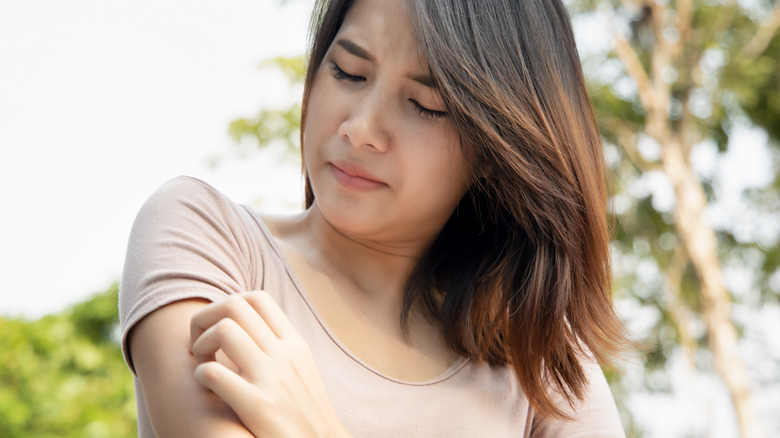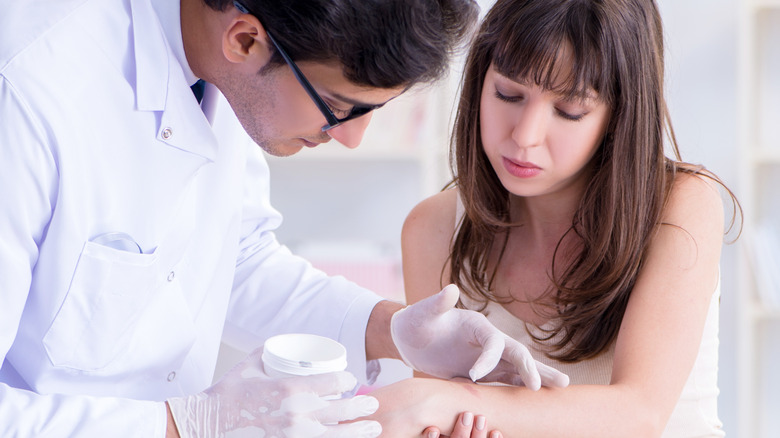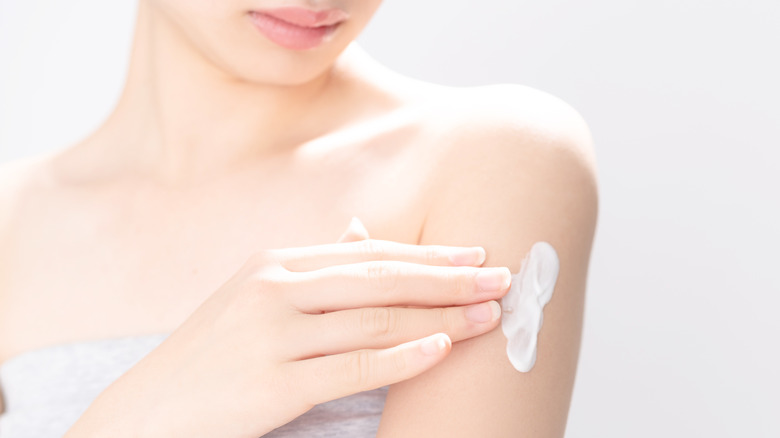What Actually Causes Acne On Your Arms?
Hair follicles, tube-shaped openings on the outer layer of the skin, are found all over our bodies. Many people confuse hair follicles for pores, but pores are actually the openings to hair follicles, the bottom of which is where hair grows. When hair follicles get plugged due to excess oil or dead skin cells, they spread and burst, causing acne to develop under the skin. As bacteria from the ruptured follicles expand, more follicles become clogged, causing more pimples to form and a breakout to flare, per Healthline. Since our skin is covered in follicles, acne can flare up almost anywhere, including our arms.
That said, not every lesion on your arm is caused by acne. Keratosis and folliculitis also resemble acne, but they are distinct skin disorders requiring different treatments. Keratosis, which manifests as hard, white pimples devoid of bacteria and pus, is a skin condition that usually develops among those with dry skin or skin allergies, Tiege Hanley points out. In contrast to acne, which is induced by blocked pores, folliculitis is caused by inflamed or infected hair follicles. Folliculitis, which begins as red, pus-filled pimples that can become itchy and irritable, is prevalent in those who shave frequently or sweat excessively. To remove irksome bumps on your arms, it's important to first discern what condition you're dealing with. If you're certain the bumps on your arm are acne, let's look at the reasons and treatments available for you.
Trapped sweat and lack of hygiene are acne's best friend
According to Proactiv, perspiring excessively and frequently under tight sportswear is a likely cause of arm acne. In a humid environment like under a snug, sweat-dampened outfit with unbreathable fabric, sweat combined with sebum and dead skin cells can easily give birth to acne. With continuous movements and friction, the pores in your arm become clogged, causing non-inflamed blemishes to grow into red, swollen pimples. Sharing this point of view, dermatologist Annie Gonzalez tells Byrdie that tight clothing with sweat trapped underneath is what contributes to breakouts on the arms.
Hormonal changes and your skincare routine also play parts in promoting the growth of acne-causing bacteria on the skin. Comparing your arms with your face, Gonzalez notes that pimples flare on your arms for the same reason that they pop on your face, and that reason is a lack of proper washing. Failing to wash your body frequently causes dead skin cells, sweat, and dirt to accumulate and produce pimples (via Byrdie). If you're breaking out on your arm, check out these ways to get rid of those bumps as well as keep them from flaring up again.
How to get rid of acne on your arms
According to BeBeautiful, some over-the-counter medications that help with treating arm acne include creams or cleansers containing salicylic acid or benzoyl peroxide. Known for its ability to exfoliate the skin and clear up pores, salicylic acid has been proven effective against mild acne, such as blackheads and whiteheads. As for benzoyl peroxide, this skincare powerhouse works as an antiseptic to destroy the bacteria underneath the skin. Procedures that break up scar tissue and promote the production of new skin cells like laser therapy, light therapy, and chemical peels, are also ideal treatments for arm acne. Even when there is a cure, prevention is still preferable.
To avoid arm acne, Medical News Today recommends keeping good hygiene to prevent impurities from blocking the follicles. Also, take care to shower using mild soap after a sweaty workout, and wash your clothes and bedding regularly with scent-free detergent. If you work out often, build a stash of breathable athletic wear for maximal heat and moisture control. Since tight clothing is a huge offender when it comes to arm acne, try to wear loose clothing whenever possible. Also, refrain from popping pimples to avoid disrupting the skin structure and causing more infection.
Ultimately, good overall hygiene, not-too-tight clothes, and tried-and-true acne-treating medications can help prevent and reduce arm acne. However, if your breakouts are showing no signs of easing, you should consult a dermatologist for proper diagnosis and timely treatment.


